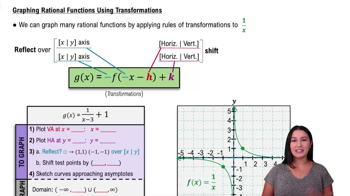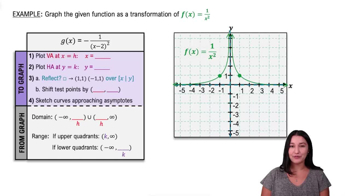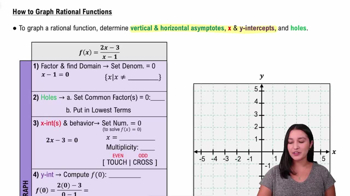Table of contents
- 0. Review of Algebra4h 16m
- 1. Equations & Inequalities3h 18m
- 2. Graphs of Equations43m
- 3. Functions2h 17m
- 4. Polynomial Functions1h 44m
- 5. Rational Functions1h 23m
- 6. Exponential & Logarithmic Functions2h 28m
- 7. Systems of Equations & Matrices4h 6m
- 8. Conic Sections2h 23m
- 9. Sequences, Series, & Induction1h 19m
- 10. Combinatorics & Probability1h 45m
5. Rational Functions
Graphing Rational Functions
Problem 50a
Textbook Question
Work each problem. Choices A–D below show the four ways in which the graph of a rational function can approach the vertical line x=2 as an asymptote. Identify the graph of each rational function defined in parts (a) – (d). ƒ(x)=1/(x-2)^2
 Verified step by step guidance
Verified step by step guidance1
Identify the vertical asymptote by setting the denominator equal to zero: \(x - 2 = 0\).
Solve for \(x\) to find the vertical asymptote: \(x = 2\).
Recognize that the function \(f(x) = \frac{1}{(x-2)^2}\) is undefined at \(x = 2\), indicating a vertical asymptote at this point.
Since the denominator is squared, the function approaches infinity on both sides of the asymptote, meaning the graph will rise on both sides as it approaches \(x = 2\).
Conclude that the graph of the function will have a vertical asymptote at \(x = 2\) and will approach infinity from both sides.
Recommended similar problem, with video answer:
 Verified Solution
Verified SolutionThis video solution was recommended by our tutors as helpful for the problem above
Video duration:
4mPlay a video:
Was this helpful?
Key Concepts
Here are the essential concepts you must grasp in order to answer the question correctly.
Rational Functions
A rational function is a function that can be expressed as the ratio of two polynomials. The general form is ƒ(x) = P(x)/Q(x), where P and Q are polynomials. Understanding rational functions is crucial for analyzing their behavior, particularly in relation to asymptotes, which occur where the function is undefined.
Recommended video:

Intro to Rational Functions
Vertical Asymptotes
Vertical asymptotes are vertical lines that represent values of x where a rational function approaches infinity or negative infinity. They occur at values of x that make the denominator zero, provided the numerator is not also zero at those points. In the given function, the vertical asymptote is at x=2, indicating that as x approaches 2, the function's value increases without bound.
Recommended video:

Determining Vertical Asymptotes
Behavior Near Asymptotes
The behavior of a rational function near its asymptotes is essential for understanding its graph. As x approaches a vertical asymptote, the function's value can either increase or decrease without bound, depending on the direction of approach. For the function ƒ(x)=1/(x-2)^2, as x approaches 2 from either side, the function approaches positive infinity, indicating a specific type of behavior around the asymptote.
Recommended video:

Introduction to Asymptotes

 5:31m
5:31mWatch next
Master Graphing Rational Functions Using Transformations with a bite sized video explanation from Callie
Start learningRelated Videos
Related Practice




